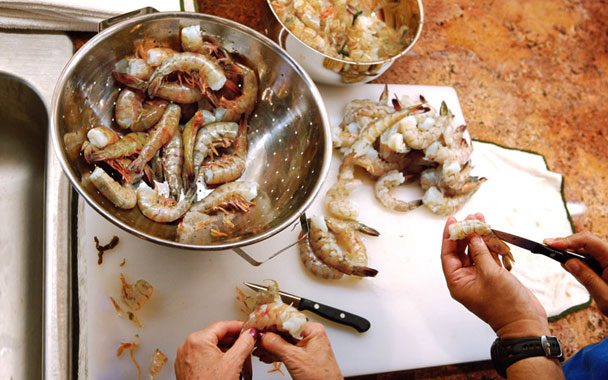Rancho La Puerta Fitness Resort & Spa is a health farm of the old school. Check in to one of the rancheras, some with French doors opening onto a terrace and others with fireplaces, at the 68-year-old facility in the arid landscape of northern Mexico for a week of hikes before sunrise, morning water aerobics, periodic “Road to Wellness” lectures, strength and sculpt classes, and lunchtime plates of cottage cheese, raw vegetables, and lettuce (calorie counts are displayed above the buffet stations and Beano sits on a small saucer like a condiment). The place serves no meat, frowns on salt, and is vehemently low-fat.
And yet last year it opened its very own cooking school and “culinary center,” a five-minute drive from the resort. It offers weekly classes given by house chef Jesús González and by such visiting instructors as Molly Stevens, the 2006 International Association of Culinary Professionals Cooking Teacher of the Year, all fairly basic and geared toward preparing healthy meals. “I would never get a [full-time] job at the ranch,” Molly said with a smile as she addressed the 16 of us who’d forfeited an afternoon of yoga and cardio cycling to take a class with her. “At home, I use butter, I use salt. I cook everything from organ meat to lamb shank.” She didn’t need any of that here, of course, because La Cocina que Canta, which claims to be the first-ever spa (read: diet) cooking school, promotes a different kind of cuisine.
It sounds hokey, but only until you go out into the six-acre organic farm, pick kumquats off the short trees by the chicken coop, find a perfect head of broccoli growing under smooth green leaves, discover that chard grows from stems that come in a rainbow of colors, and meet Salvador Tinajero, the head gardener, who speaks of his experiments with, for instance, pear trees in a reverent tone that’s part scientist, part Cyrano.
On any given day, the majority of ingredients used in class will come from just outside the big open kitchen. For Molly’s seven-dish menu, there were carrots, two types of spinach, broccoli, celery, onions, small bulbs of fennel, and that rainbow chard. And for our group—an eclectic collection of retirees, professionals, working mothers, and ladies of leisure—the harvest was as much a lesson as any technique. (The whole farm-to-fork idea is put into practice, and the word diet is redefined to mean eating real food instead of the prepackaged, processed stuff.) “I believe in making things from scratch,” said Molly, in her nice, neighborly way.
Cooking classes were open to all, from the beginner who might learn how to dice a shallot—no, how to identify a shallot—to the serious home cook who might benefit from an afternoon of teamwork. I, for one, improved my knife skills, while my teammate heard the expression mise en place for the first time. Over the course of two hours, we chopped, shredded, sautéed, roasted, zested, and puréed, while Molly darted around in her funny magenta clogs to tutor (drizzle a little bit of balsamic vinegar on roasted fennel, then put it back in the oven for a minute to slightly caramelize the bulbs), to advise (yes, remove the green bit at the center of a garlic clove), and to taste (“pepper is called ‘love’ in my house, and that needs a little love”). There were shouts and applause when one team’s pita breads actually puffed up the way they were supposed to. And when we all sat down at the long wooden table to eat the big meal we’d made—from curried carrot soup to sautéed shrimp—we were giddy with a sense of shared accomplishment. Or maybe that was the wine. Ordinarily, the ranch doesn’t serve anything stronger than Red Zinger tea, except at dinner on the last night, when local bottles of red and white are opened in celebration. It’s a health farm, after all—and I’ve got the recipe for wheat-berry salad with mizuna, citrus, and pine nuts to prove it. (800- 443-7565; rancholapuerta.com; from $2,795 per week, double occupancy, including meals and many activities; hands-on cooking classes are an extra $75 each)
What I Learned
If you pull an onion at an angle, it will come out of the dirt with less of a fight than if you pull it up vertically.
Biggest Surprise
That it’s possible to survive a week without meat.
Before You Go
Break in your hiking shoes.

